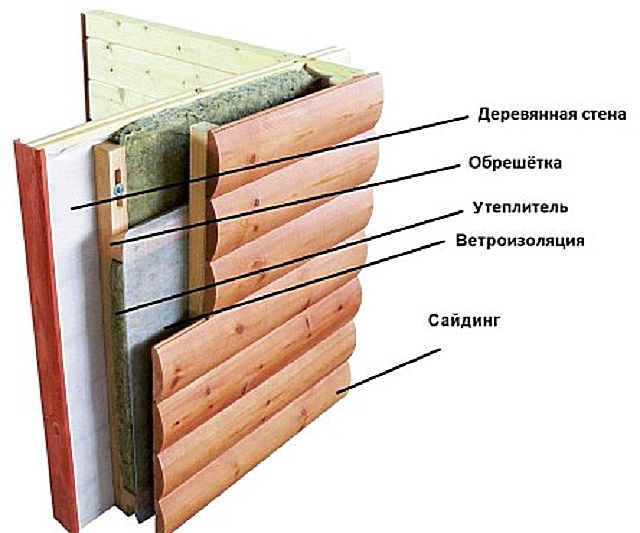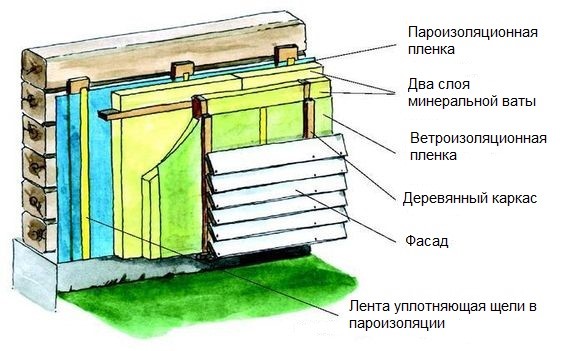Some people ask the question, is it necessary to insulate a house from a bar? Wooden buildings retain heat well, even if they are old. However, if the walls of a log house are well insulated, this will significantly save on energy costs. Therefore, over time, this procedure will pay off with interest. Next, consider how and what is the best way to insulate a wooden house.
How to properly insulate a house from a bar - this question is asked by many ordinary people. Conventionally, two methods can be distinguished - internal and external. We strongly recommend using the second one (that is, fixing the heat insulator directly to the walls of the facade).
This method has many advantages:
- Absolute protection against condensation. When the walls are insulated inside the building, moisture begins to appear due to the temperature difference, which contributes to the formation of mold and mildew. External thermal insulation eliminates this, which significantly increases the operational period of materials.
- Increased efficiency. If the walls are insulated from the inside, then they will not form part of the heat-insulating layer. By hiding them from direct contact with street air, you can increase the efficiency of the structure as a whole. This is especially true for timber 150 × 150 and less.
- The useful volume of the dwelling does not decrease. When decorating the walls from the inside, the area will be reduced by 5-10%. This is especially important for owners of already small houses.
- Excellent protection of walls from all kinds of atmospheric phenomena (temperature changes, humidity, UV rays, etc.). This increases their operational period several times.
- The ability to kill two birds with one stone. In addition to organizing protection from the cold, you will restore the walls of the facade.
Three methods of external thermal insulation
How to insulate a log house? There are three options for external wall insulation. Next, we will briefly consider the features of each of them.
"Well"
This is a very time consuming, expensive, but very effective technique. It is mainly used for brick buildings. It consists in the following: the heat insulator is attached to the facade (in any way), and a wall is built close to it (for example, made of bricks).
The technique is somewhat outlandish, but it carries the maximum thermal protection. Therefore, it is used mainly in the regions of the far north, where in winter the temperature drops below minus 60 degrees. However, with the advent of more advanced materials, it is gradually forgotten.
Wet bonding technology
It consists in the following: the insulator is glued to the walls, after which it is additionally fixed with special dowels. Then the surface is covered with a reinforcing mesh, which is then finished with "warm plaster" for outdoor use.
Also a rather outlandish method that allows you to turn a wooden house into a brick one. In any case, outwardly it will look exactly like this. The efficiency of this method is very high, but it carries a significant disadvantage - the complexity of the work. Only a specialist can handle it.

This is the most common technology today - 9 out of 10 new homes get off like this. It implies the creation of a frame on the facade, into which the heat insulator is subsequently placed. At the end, the structure is covered with any finishing material to exclude exposure to UV rays.
How to insulate a log house is up to you. The simplest and most accessible technique is a ventilated facade (we will talk about it in more detail later), and the most effective is a "well".

Basic requirements for thermal insulation material
How to choose insulation for a log house? To make the only correct decision, you need to know the basic criteria. In particular, this group of materials must have the following properties:
- Environmental Safety.
Obviously, if you opt for toxic models, then one of the main advantages of wood (natural origin) will disappear. Therefore, it is necessary to use natural analogs, these include ecowool, penoplex, basalt wool, etc.
- Coefficient of thermal conductivity (the ability of a substance to pass warm air through itself).
This is a key characteristic of a heat-insulating material, on which its efficiency directly depends (the lower it is, the better). However, all modern models meet the established requirements.
Tip: for a 150 × 150 log house, it is advisable to create two layers of insulation.
- Non-flammability.
Unfortunately, most of modern insulators are subject to combustion to one degree or another. So, Penoplex, which is gaining high popularity, can smolder for several hours (along with the walls). The clear leader in this aspect is foam glass - a porous material sold in the form of slabs. However, it has two serious drawbacks - heavy weight and impressive cost. There are other solutions: before insulating a wooden house, treat all floors with protective compounds (they will prevent the wood from catching fire).
- Resistant to organic attack.
If the house is old, then the walls will eventually begin to become covered with fungus or mold. Therefore, it is necessary to opt for insulators that are resistant to such consequences.
There is no perfect insulation that would more than meet all the requirements. For example, penoplex has better efficiency and less weight, but at the same time it burns well and releases toxic substances. Its counterparts, which are environmentally friendly and non-combustible, are less efficient. Therefore, you will have to choose the "lesser of two evils" (safety or effectiveness).
Consider the stages of work
As we have already said, the most accessible technology is a ventilated facade, so we will focus on it. Regardless of the chosen insulation, the method of work will be approximately the same. Next, let's look at the main points.
Initial surface preparation
Before insulating the log house, you will need to make some preliminary manipulations, namely:
- Completely dismantle the facade cladding (siding, boards, etc.). If it is in good condition, then do it carefully, as it can be reused later.
Important! Some people find that it is effective to lay the heat insulator directly on the tiled surface and then redecorate it. The thicker the wall, the better it is protected from the cold - this is the conclusion that ordinary people come to. This is a fundamentally erroneous opinion, since in the presence of cavities, cold bridges are formed in the ceilings, and this leads to the appearance of condensation and mold, which significantly reduces the "life" of all materials.
- Having reached the bar, we assess its condition. If, as a result of shrinkage, cracks or cracks have formed, we close them (for this you can use professional polyurethane foam). As a result, the walls should turn out to be airtight - this will prevent the formation of condensation inside.
- Next, you need to treat all the wood with various impregnations (antiseptic, protective compounds, etc.). This will increase the lifespan of the walls many times over. To do everything quickly, you can use a special spray. Remember to wear a respirator.

Vapor barrier and frame construction
Before insulating a house from a bar, it is necessary to protect the materials from the effects of moisture, which will appear due to the temperature difference. It is necessary to glue some kind of vapor barrier material on the prepared walls. It can be a special membrane, film or even roofing material (we recommend staying with the first option). Even the smallest gaps should not be allowed.
After that, we construct a frame of boards (for example, "forty"). We put them vertically on the stiffeners. In this case, the distance between them should be chosen such that it is 1-2 less than the width of the selected insulation. Then we add some horizontal rows.
Insulation laying and final operations
It remains to perform a few simple manipulations:
- We put heat-insulating material in the niches between the guides. We fix it with self-tapping screws or glue. If the house is made of 150x150 timber, then it is better to make 2 layers.
- Then, on the previously created frame, we attach a moisture-proof film over the entire area of the building. As a result, our insulation will be closed on all sides (sandwich technology) and it will not be afraid of weather conditions at all.
- At the end, we cover the surface with some kind of facing material.
That's all. Now you know how to insulate a house from a bar.



